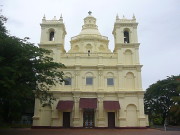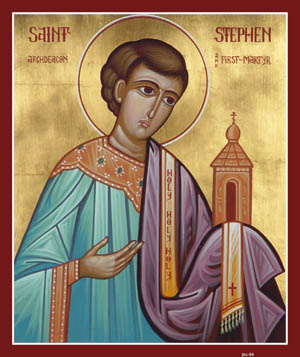
St. Stephen

St. Stephen or Stephan is traditionally venerated as the Protomartyr or first martyr of Christianity, was according to the Acts of the Apostles a deacon in the early church at Jerusalem who aroused the enmity of members of various synagogues by his teachings. Accused of blasphemy, at his trial he made a long speech denouncing the Jewish authorities who were sitting in judgment on him and was then stoned to death. His martyrdom was witnessed by Saul of Tarsus, a Pharisee who would later himself become a follower of Jesus.
The only primary source for information about Stephen is the New Testament book of the Acts of the Apostles. Stephen is mentioned in Acts 6 as one of the Greek-speaking Hellenistic Jews selected to participate in a fairer distribution of welfare to the Greek-speaking widows.
The Catholic, Anglican, Lutheran, Oriental Orthodox and Eastern Orthodox Churches venerate Stephen as a saint. Stephen’s name is derived from the Greek language Stephanos, meaning “crown”. Traditionally, Stephen is invested with a crown of martyrdom; artistic representations often depict him with three stones and the martyr’s palm frond. Eastern Christian iconography shows him as a young, beardless man with a tonsure, wearing a deacon’s vestments, and often holding a miniature church building or a censer.
Acts 8:2 says “Godly men buried Stephen and mourned deeply for him”, but the location where he was buried is not specified.
In 415 AD a priest named Lucian purportedly had a dream that revealed the location of Stephen’s remains at Beit Jimal. After that, the relics of the protomartyr were taken in procession to the Church of Hagia Sion on December 26, 415, making it the date for the feast of St. Stephen. In 439, the relics were translated to a new church north of the Damascus Gate built by the empress Aelia Eudocia in honor of St. Stephen. This church was destroyed in the 12th century. A 20th-century French Catholic church, St Etienne, was built in its place, while another, the Greek Orthodox Church of St Stephen was built at the site of his martyrdom.
The relics of the protomartyr were later translated to Rome by Pope Pelagius II during the construction of the basilica of San Lorenzo fuori le Mura. They were interred alongside the relics of St. Lawrence, whose tomb is enshrined within the church. According to the Golden Legend, the relics of Lawrence moved miraculously to one side to make room for those of Stephen.[14]
In his book, The City of God, St. Augustine describes the many miracles that occurred when part of the relics of St. Stephen were brought to Africa.[15]
Part of the right arm of Saint Stephen is enshrined at Trinity Lavra of St. Sergius in Russia.